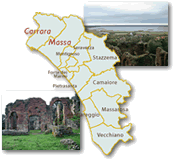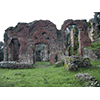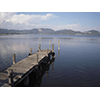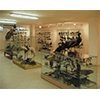Versilia - Around Lake Massaciuccoli

A few kilometres from the Versilia coast, Lake Massaciuccoli was quite important in the past. A place of great naturalistic interest that still today conserves traces of its long history, as early as the Roman age, it was concerned by major reclamation works. The lake has recently become part of the Migliarino-San Rossore-Massaciuccoli regional park. The itinerary proposes to illustrate several tokens of its history.
One of the most fascinating views of the lake is doubtlessly the one you can enjoy from the Villa Romana of Massaciuccoli, situated halfway between Lucca and the coast, in the vicinity of the town of Massaciuccoli, on the Via di Pietra Padule. It is a worthwhile experience to stop and admire the remains of the ancient structures, fruit of the technical skill of the ancient Romans.

On the slopes of Mount Aquilata, on the side overlooking Lake Massaciuccoli, stand the ruins of an ancient Roman villa from the I century A.D., attributed to the Pisan family of the Venulei, whose name appears on a copper water pipe that used to furnish water to the villa. The first information on the villa dates from the year 874 when, on the occasion of an exchange of property, a document was compiled in which a "wall said to be antique" was mentioned. Apart from a few references in the Chronicles of Lucca, dating from 1472, there is nothing else until the 18th century when, in coincidence with the finding of more detailed descriptions of the place and drawings, the first archaeological excavations were begun. The archaeological research, unfortunately poorly documented, conducted in 1756 behind the apse of the parish church of San Lorenzo, brought to light at least two rooms, one with flooring in opus sectile (a composition of colored stones of various shapes and sizes), the other with a mosaic floor in black and white tesserae, of which there exists a reproduction on canvas, the work of an anonymous eighteenth-century artist, now found in the Villa Guinigi National Museum in Lucca. The reports on the excavations also mention a "pool" dug out of the sandstone and fed by two lead water-pipes.
Thanks to more recent excavations, such as those conducted by Antonio Minto in 1920, and to the investigations of 1991-92, it has been seen that the monument extends over two terraces variously rebuilt over the course of time. Particular interest as regards scientific aspects has always been aroused by the structures forming the heart of this monument. Minto believed them to be the central part of a thermal baths building, interpreting the rectangular room with the pool as a frigidarium and the apse-shaped room to the north of it as the calida lavatio [hot bath]. A recent hypothesis suggests, instead, that the three rooms constitute a "triclinium-nymphaeum", according to a scheme favoured by the architecture of Neronian and Flavian times. The nymphaeum would have received water from a system, already identified by Minto as a castellum, located between the two terraces. A further room, completely occupied by a white marble pool with three steps, was interpreted by Minto as the place of the calida lavatio, due to the presence of a hollow underground area with suspensurae (terracotta pilasters that supported the floor above, allowing hot air to circulate through the hollow space) and a central room where the furnace was located. It has recently been hypothesised instead that the room was a sudatio [sweating place], based on comparison with similar structures found in Domitian's Villa at Sabaudia and in Hadrin's Villa at Tivoli. Further evidence consists of a lead plate inserted in the part of the floor must severely subjected to the heat, a technique adopted also in the thermal baths at Tivoli.
Today the monumental remains of these structures stand out against a panorama of striking visual impact.
At the bottom of the heights where the villa is, another building was identified during the 1930s. It has been described as a mansio, ie a leisure station, as indicated by the presence of a series of rooms overlooking a courtyard and connected by a corridor to a thermal environment from which one can still admire a fine black and white tiled mosaic. Such a place was probably run by the owners of the villa, as it was quite frequent in the economic-social structure of that time.
The complex has recently been incorporated into a modern structure made of wood, glass and metal that allows, thanks to the presence of footbridges, to visit all the rooms. Inside this small museum is also possible to retrace the historical formation of the villa through the display of the most significant finds discovered in the complex.
(Elena Fani)
After the visit, you can go down to the lake shore and take the unpaved roads of the reclamation area, or else one of the many boat rides proposed at Torre del Lago Puccini for an ecological excursion on the lake and its canals.

In the past, Lake Massaciuccoli had a greater reach which also included an extensive swamp area that was the frequent cause of malaria. The hydraulic problems tied to this environment were already confronted by the Romans, and as of the 14th century were targeted several times with various projects which did not obtain the desired results. In the first half of the 18th century, mathematician Bernardino Zendrini from Venice thought that the best solution to reclaim the area was to prevent the fresh water of the lake from mixing with the salty sea water. For this reason, in 1741, he built floodgates between the lake and the port of Viareggio, which partially reclaimed the environment, though vast areas remained to reclaim, becoming the object of study by famous hydraulic engineers like Tommaso Perelli, Leonardo Ximenes, Giuseppe Ruggero Boscovich and Eustachio Zanotti.
In the early 19th century, Lorenzo Nottolini proposed a project that connected the basin of Bientina with that of Massaciuccoli. With a single solution, Nottolini sought to solve several urgent hydrographical problems, such as the recurrent flooding of the Serchio by reclaiming Lake Bientina and filling Massaciuccoli Swamp. The "Grand Project" – as contemporaries defined it – provided for diverting the course of the Serchio from Lucca towards Migliarino. The river in full spate, loaded with detritus, would have favoured filling the area of Massaciuccoli. Finally, a canal which was supposed to join Lake Bientina with the Serchio River, its bed by now free, would have emptied the lake itself. The project was not carried out due to the enormous costs, as well as to bureaucratic problems, as part of the area affected by the work concerned both the Duchy of Lucca and the Grand Duchy of Tuscany.
The extraction from the lake bed of a precious siliceous sand, used in the building and glassmaking industries, began as of the mid 19th century.
Only in the 20th century were vast wetland areas reclaimed in the Massaciuccoli area, which is today part of the nature reserve of Migliarino-San Rossore-Massaciuccoli.
(Graziano Magrini)
To conclude the itinerary, a visit to the local Centro Espositivo di Scienze Naturali with its small but interesting collection of taxidermied animals will give you an overview of the faunistic patrimony of this special ecosystem.

The centre displays various specimens of stuffed birds, exhibited in a room in the basement of the Torre del Lago Puccini Civic Centre. Remarkable for their beauty are several specimens inhabiting Lake Massaciuccoli, as well as two flamingos, a white swan, a crane, a cormorant, and a blue, a white and a red heron. The exhibition facilities were realised thanks to the donation of Elio Gragnani.
(Graziano Magrini)
****************************
Texts by Elena Fani
English translation by Victor Beard
Last update 23/feb/2008



 = libraries and archives
= libraries and archives  = scientific research centers
= scientific research centers  = memorial places of scientists
= memorial places of scientists = public health places
= public health places = places of science and worship
= places of science and worship = places of technology
= places of technology  = museums and collections
= museums and collections  = villas and gardens of science
= villas and gardens of science


